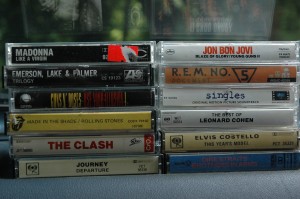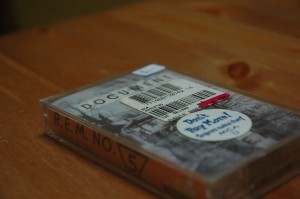KATE REID (www.katereid.net) is a critically acclaimed Canadian singer-songwriter. She was recently interviewed by local writer/musician Andrea June. Reid performs Sunday, October 14 at 4 p.m. at The Well, 821 Fort Street. (Tickets $20 at the door)
.
CS: Your music focuses primarily on queer experiences, from mournful songs about violence to the hilarious “Only Dyke at the Open Mic.” While you proudly promote this focus, media coverage and also points out that your music is for “everyone.” Who are your audiences? Has this evolved over the years?
Kate: While my audience is primarily queer-based, I also have an enthusiastic audience of people who are not in the LGBTQ community — people who identify as heterosexual and who enjoy my music because they see the social relevance of it, enjoy the humour and the stories and understand that the lyrics are more universal than at first glance. My audience has definitely evolved over the years partly because — besides playing PRIDE festivals and queer music venues — I also perform at folk music festivals and other festivals where the bulk of the audience is from outside of the LGBTQ community. Perhaps my audience has also diversified over the years simply because people are becoming more open-minded to LGBTQ issues — that is one of my hopes anyway.
CS: You have three albums out now: Comin’ Alive, I’m Just Warming Up, and Doing it for the Chicks. Yeah, you’re pretty much a Canadian dyke icon at this point. So now that we’re alive, warmed up, and doing it, what’s next?
Kate: Ha ha, dyke icon? I don’t know if that’s true, is it? The project that I’m currently working on is a musical-educational project. It’s comprised of a 17-song recording plus a kit for educators, focusing on the harmful effects of bullying, homophobia and heterosexism, as well as celebrating diverse genders, sexualities, people, families and communities. The idea of doing this project came to me when I met a woman at a folk festival who was pulling a wagon with two kids behind her. My wife knew her and they were catching up after a number of years of not seeing each other. My wife inquired about the kids, asking if they were hers because they looked very similar. The woman laughed and said that one of the children belonged to her and her partner and the other child belonged to another lesbian couple, and the reason why the children look similar is because they had the same father, they share the same donor dad. When I heard this, my mind just starting racing, thinking about all of the possibilities of families out there, especially in the LGBTQ community where the decision to have children has to be a well-thought-out, planned decision. I went home that day and wrote out a list of all of the possible family combinations . . . it was a long list. The concept for this album was further cemented in my mind as a project I needed to do because the two children I am helping to parent tell us they sometimes have difficulty in school explaining why they have two moms and don’t have a father. They have to explain what a “donor dad” is and sometimes they get teased for it. I realized that children growing up in the LGBT community don’t have any children’s songs that relate to their families and the things they may experience because they have gay, lesbian or transgendered parents. I thought it was time that I wrote those songs for them. So, I put out a call to interview children and their parents and then conducted close to 40 interviews with children and their LGBTQ parents and wrote songs about some of their stories and experiences. Then, I realized that if I combined my B. Ed with my musical career, I could create a really cool kit for schools that brought these stories and songs into the classroom. So, besides recording the songs, I have been developing lesson plans, activities and projects to pair with the songs to teach about LGBTQ families. This project is set for release in 2013.
CS: You also offer workshops for secondary and post-secondary schools aimed at teaching students about oppression and stereotypes, with regards to gender and sexuality in particular. What led to this initiative?
Kate: I wanted to offer these because I love working with youth and have done so for many years as a teacher, community support worker, youth camp coordinator and teaching assistant. I aim to bring awareness into schools about visibility for LGBTQ people and the different kinds of oppression. I want youth to discover the benefits of self-expression through writing – that it is a way to heal oneself, to tell one’s story and to heal others in the telling of that story. Writing, along with music and feminism, saved my life and I want to pass that on to youth who may be struggling to figure themselves out. Writing our stories can help us make sense of ourselves, our lives and how we fit into the world around us.
CS: It’s hard not to focus on the “activism” aspect of your music, but you also have an awesome voice — the pure, resonant tone of Joni Mitchell, with the powerful delivery of a rock musician. You keep calling yourself folk-country, but I think you may be in the closet as a rock musician. How did you start playing music? What inspires you, musically?
Kate: Ha, you figured me out! I am a closet rocker. I love classic rock and certainly listened to lots of it in my childhood and youth, from early 50s rock ‘n’ roll to 60s psychedelic rock and 70s classic and glam rock, but I also really love acoustic guitar and I like being a solo artist. My first record was Linda Rhondstadt’s Living in the USA. I played it on my Fisher-Price red and yellow turntable when I was around seven years old . . . I started singing when I was really young — in my Christian school choir and at summer camp. Our school music teacher taught us Handel’s Hallelujah Chorus from The Messiah. It was incredible to sing that as a child. I loved the sound and the feeling of all of our voices harmonizing together. When I was young and identified as a Christian, I used to think that was what God felt like. Now I know that that is what it feels like when people come together and sing, sharing their voices and souls with each other. I would love to sing in a choir again someday.
Later on, I discovered folk artists like Peter, Paul and Mary. I also listened to Kenny Rogers, Dolly Parton, The Beatles (and, I have to state for the record, I’m not a Beatles fan anymore), and lots of 80s pop and rock, which I still love! I discovered Bob Dylan in high school. I loved his writing — even though I didn’t really get it at the time – it was unlike anything I had ever heard before. Tracy Chapman’s first hit Fastcar got inside of me. Her voice was so different and the lyrics spoke to me even though I was a white, middle class kid living in rural Canada. In university I was hooked on Joni Mitchell’s Blue for an entire year. I also loved Court and Spark. My sister introduced me to the Indigo Girls and I loved them. I knew they were lesbians and when they were singing about love, and I remember feeling intrigued and uncomfortable at the same time, but I kept listening. Then, I discovered Ani Difranco and wham, I was hooked on women’s voices. She sang about stuff no one was singing about. Blood in the Boardroom? A song about women and bleeding and power? I was mesmerized and empowered. When I discovered Ferron, I knew I’d found something important, someone who could write her soul. I will always be a huge Ferron fan. I also listen to lots of classical music and new age stuff with birds and waterfalls and shit like that.
CS: Quick — if I gave you a million dollars, what would you do with it?
Kate: If I had a million bucks, I would build a one-room adobe cabin in New Mexico (so I could get away and song-write) and a straw bale house on a few acres in BC (to live in) and then open a shelter for queer homeless youth (turn it into a non-profit ) so they could have a safe, supportive, LGBTQ place to live while they finished schools and started to figure out their next life moves.
Click Here to Watch a Live Performance



